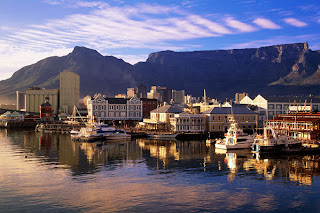Ethnic Groups
Until 1991, South African law divided the population into four major racial categories: (1.) The Black Africans, of which the Nguni and Sotho groups account for 90% of the Black population. Black population accounts 75% of the South Africa's entire population. (2.) The Whites who account for about 13% of the population. (3.) The Indians who account for around 3 % and (4.) the Coloreds who are mixed White and Black descent and account for 9% of the population. Although the South African law of racial categories has been abolished, many South Africans still view themselves according to these categories.
 The black population consists of several groups: Khoi-San, Xhosa, Zulu, Ndebele, Sotho, Shangaan and Venda, just to name a few. The biggest groups are Zulus (21 %), Xhosas (17 %) and the Sotho (15%). Next smaller minorities are the Tswana, Venda, Ndebele, Swasi, and Pedi, among others. The Khoi-Sans are originally hunter-gatherers who have inhabited the land for a long time. Many political leaders, Nelson Mandela among them, come from the Xhosa. Most of the Blacks used to live in the countryside following a traditional way of life, but a class of progressive farmers also formed. Many of these became Christians and had some education from Missionaries. In the towns many Blacks worked as labourers. A small class of professional newspaper editors, lawyers and teachers emerged.
The black population consists of several groups: Khoi-San, Xhosa, Zulu, Ndebele, Sotho, Shangaan and Venda, just to name a few. The biggest groups are Zulus (21 %), Xhosas (17 %) and the Sotho (15%). Next smaller minorities are the Tswana, Venda, Ndebele, Swasi, and Pedi, among others. The Khoi-Sans are originally hunter-gatherers who have inhabited the land for a long time. Many political leaders, Nelson Mandela among them, come from the Xhosa. Most of the Blacks used to live in the countryside following a traditional way of life, but a class of progressive farmers also formed. Many of these became Christians and had some education from Missionaries. In the towns many Blacks worked as labourers. A small class of professional newspaper editors, lawyers and teachers emerged.The apartheid regime over-emphasised the differences among the various ethnic group, mainly between whites and non-whites, but also between black groups (i.e. Xhosas and Zulus), and turned them against each other rather than against the government. The policy of racial segregation favoured the political and economic power for the white minority. Until today, South Africa has to deal with the consequences of this disastrous policy. Large part of the fast growing black majority lives in oppressive poverty in the outer districts of the cities lacking sufficient sanitation, electricity and water. Many of the residents are illiterate. The enormous poverty problem in South Africa is the major reason for the high crime rates.
The first Europeans to reach the Cape of Good Hope were Portuguese, arriving in 1488. However, permanent white settlement did not begin until 1652, when the Dutch East India Company established a provisioning station on the Cape. In subsequent decades, French Huguenot refugees, the Dutch, and Germans began to settle in the Cape. Thus, The Whites are primarily descendants of Dutch, French, English, and German settlers who arrived at the Cape in the late 17th. They are called Afrikaners and speak Afrikaans, a language closely related to the Dutch language.
The province of Natal is also home to about one million Indians, whose forefathers came to South Africa to work on the sugarcane plantations. They were brought by the British people in the 19th century. Indians were among the exploited and among the exploiters. Most were poor, having come as indentured labourers under a brutal system that was very close to slavery. When their terms of indenture expired, many stayed on as labourers or small farmers. A smaller, but more prominent group of Indians, came voluntarily to engage in trade. They opened up shops and warehouses and some of them were quite rich.
Among the non-White peoples, the second largest group is the Coloured community, 89% of whom lived in the Cape Colony. Generally thought of as a mixed-race group, it loosely included some Indians, Malays and native Africans. Like the Indians, the Coloured are neither Black nor White, and their intermediate position generated fears of being reduced to the status of the Blacks. So-called coloureds, people of mixed race are mainly still living in the Cape region. They originate from Dutch sailors inter-marrying with the Khoi-San in the 17th century. They are also descendants of the first Dutch settlers and the native population of the Cape (Khoikhoi) or the Malays, who were taken to South Africa as slaves from East India in the 18th century.
Despite the many ethnic groups, South Africa is still far from the ideal of a multi-cultural society. There is still a deep trench going through the population. Black and white people lead largely separate lives with few points of contact. Nevertheless, the society's democratisation is steadily progressing. A national commission attempts to make people conscious about the crimes of apartheid by letting them be publicly confessed with the aim of forgiveness. South Africa is, in respect of overcoming racism, in the spotlight of the world like no other country. The future of the state largely depends upon its ability to create equal opportunities for all people.













